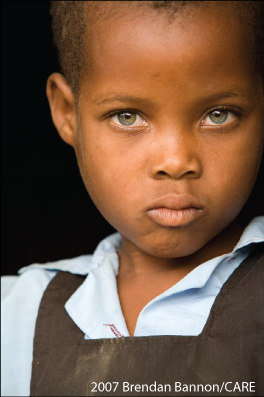
Download the CARE Anuual Report
Full Annual Report (PDF, 7.0 MB)Financial Statements (PDF, 308 KB)
Return Home
About CARE
CARE is a leading humanitarian organization dedicated to fighting poverty and social injustice. We place special emphasis on investing in women and girls because our six decades of experience show that their empowerment benefits whole communities. Last year, CARE worked in 84 countries around the world, supporting 1,015 poverty-fighting projects to reach almost 130 million people, over half of whom are women. Our emergency-response work last year reached more than 1.8 million people suffering from the famine in the Horn of Africa, where we continue to provide emergency services and supplies today. Underpinning all our work is a commitment to using evidence-based policy advocacy to address underlying causes of poverty, such as poor governance, gender inequity, and economic and social exclusion.
- Latin America & Caribbean
- Peru
- Haiti
- Bolivia
- Honduras
- El Salvador
- Africa
- Zambia
- Angola
- Ghana
- Sudan
- Rwanda
- Middle East & Europe
- West Bank/Gaza
- Egypt
- Georgia
- Kosovo
- Bosnia
- Asia
- Vietnam
- Afghanistan
- India
- Nepal
- Sri Lanka
Our Programs
CARE tackles underlying causes of poverty so that people can become self-sufficient. Recognizing that women and children suffer disproportionately from poverty and natural disasters, CARE places special emphasis on working with women to create permanent social change. Each one of our programs strives to fulfill our mission as an organization to serve individuals and families in the poorest communities in the world.
- Emergency Relief
- Education
- HIV/Aids
- Cross-Cutting Initiatives
- Water
- Nutrition
- Agricultural & Natural Resources
- Economic Development
- Health
Our History
CARE was founded in 1945, when 22 American organizations came together to rush lifesaving CARE Packages to survivors of World War II. Thousands of Americans, including President Harry S. Truman, contributed to the effort. On May 11, 1946, the first 20,000 packages reached the battered port of Le Havre, France. Some 100 million more CARE Packages reached people in need during the next two decades, first in Europe and later in Asia and other parts of the developing world.
1948 CARE airlifts food to Berlin when Soviet troops blockade the city. A CARE food truck is the first vehicle to enter Berlin after the blockade is lifted.
1954 CARE starts a major relief operation in Korea as the war there expands.
1961 President John F. Kennedy establishes the Peace Corps and asks CARE to help train its first volunteers to Latin America.
1974 CARE provides food, relief kits and medical supplies to drought victims in Niger and Chad and launches agroforestry efforts to help prevent drought and increase food production.
1988 CARE becomes the first private development organization to work in the People's Republic of China and, as the Cold War wanes, begins operations in the former Soviet Union and the former Yugoslavia.
1992 CARE delivers food to 2 million people during the famine in Somalia, despite widespread violence and instability.
1994 Civil war and ethnic massacres in Rwanda send an unprecedented flood of refugees into Zaire(now Democratic Republic of Congo) and Tanzania. CARE delivers food, water and sanitation to hundreds of thousands.
1996 Smithsonian Institute inducts the CARE Package into its permanent collection.
2002 CARE unveils a bold new look, reflecting our commitment to helping families around the world achieve lasting victories over poverty.
Support CARE
Supporting CARE can satisfy your desire to make a difference and your expectation to see a return on your investment. Our record of efficiency meets the stringent guidelines of the Better Business Bureau Wise Giving Alliance.
 Consider helping women ALL YEAR LONG with a recurring monthly donation through our
Consider helping women ALL YEAR LONG with a recurring monthly donation through our Partners for Change program.


